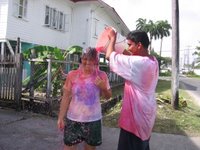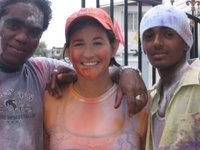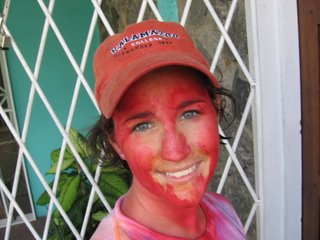 MASH MASH, MASHRAMANI!!
MASH MASH, MASHRAMANI!!Yes, yes, folks - "A Cultural Mix in 2006!" was on the road on Thursday, February 23rd, as the Mashramani (aka Republic Day) festivities took Georgetown in their colorful embrace. The event commemorates Guyana's 1966 independence from the UK. And there was singing and dancing in the streets! Get your glitter, rub it on your face and come along!

For those of you in the states, the closest thing to this type of carnival would be the old Mardi Gras "celebrations" of New Orleans. For those of you familiar with Brazilian carnival (world famous), you will know that integral parts are 1)floats, 2)themes, and 3) costumes (generally as small as humanly possible, but still ostentatious).
My friend Shoma and her mother, sister and nephew were kind enough to accompany Eileen and I and show us how things were done. They were lovely company, and it was great to "join a family" for the parade. Naipaul (Shoma's nephew) is about 2 1/2, and when he's upset now, Shoma tells me, he'll tell whoever offended him that he and Kate an

d Eileen and Shoma are all going to Mash parade and we are going to leave that person who did him wrong behind!! What a character. The picture is of him waving a tiny Guyanese flag high high high (too high for my lens!), and his mom watching the floats.
The origin of Mash:
The Jaycess of Linden had, since Guyana became independent in 1966, been arranging a organizing an Independence Carnival in McKenzie (a town a few hours out of Georgetown). With the advent of Guyana becoming a Republic in Feb 1970, the Jaycees of Linden under president Harmon Nobreiga formed a Jaycees Republic Celebrations Committee. The search for a name to replace Carnival (to make it more nationalistic and "owned" by the Guyanese) began and it was suggested by Basil Butcher (chairman of the committee) that an Amerindian name be chosen. One of the committee members (an Amerindian) held discussions with his grandfather who explained a type of Festival that was held by Amerindians whenever they gather to celebrate a special event. This event he said
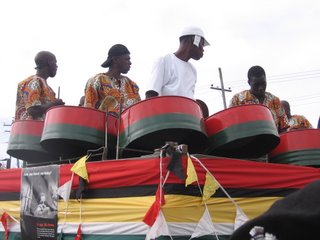
was like "Muster Many" and sounded in Arawak like Mashramani. The Amerindian word may actually be Mashirimehi, which means "Co-operative effort". On Feb 23rd, 1970 the Festival called "Mashramani" was a huge success with people drawn from all Regions of Guyana to Linden welcoming Guyana's Republic Status with over three days of frolic and fun. After witnessing the massive crowds, glitter and level of competition, Mr. David Singh a Government Official held discussion with the Jaycees Committee about bringing the event to Georgetown. Approval was also given by the then President Forbes Burnham for Mash to be he National Event for the Republic celebration. Mash activities were rotated in Linden, Berbice and Georgetown but due to sponsorship, the Costume Bands contest remained in Georgetown.

(Thanks to Jimmy Hamilton & Raymon Cummings of the Ministry of Culture, Youth and Sports for this information, posted on the VisitGt website - which I found was actually either nearly the same entry that Wikipedia used, or it was copied and not credited (Guyana is NOT famous for its adherence to copyright policies)).
In Guyana, it happens like this:
A ministry or large private company and even regions (think of them as US county) enters a "float" in the parade to be judged at a competition at the end of the parade in the National Park. Ministries include Ministry of Education, Ministry of Health, Ministry of Culture,

Youth and Sports, Ministry of Home Affairs, Ministry of Agriculture, Ministry of Amerindian Affairs and the list goes on. Private companies participating include Banks DIH (bottling and distributing company for the whole country, also produces a variety of products), Gomes optical (yes, an optometrist who is doing very well), NBIC a bank in Guyana, Cellink Plus (a cellphone company), Rayon House of Fashion (providing fabrics and ready-made clothing, I believe) and many more. I saw two floats entered by community members from specific regions. A float in this parade, though, also includes a group of 50-100 people all dressed in theme marching behind the float. Often there is a 12 foot high wall of speakers on the back of the float with soca, hiphop and calypso artists perched on top blasting

music to keep the mass of brightly colored parade participants dancing the whole way to the park. It's wild.
The parade has a theme. This year's was "a cultural mix in 2006" underscoring both the rich intercultural heritage of the country (Amerindian, Dutch, French, Portuguese, East Indian, African, Chinese, British, and "mixed") and (more subtly I thought) the suggested hope that government officials and citizens have that perhaps the differences between these groups will not overpower their unity in the face of the upcoming elections sometime this summer. Historically, the rumors go, the time leading up to elections has been marked with violence perpetrated along racial lines. However, we've also

heard that the violence was only on the two days after the elections, that it lasted months after the elections, that it was just the week before the elections ... there is no consistent story, just perceived tension. But all I saw on the 23rd was a group of scantily-clad, flag-waving, sweaty Guyanese brought together to celebrate in the sun and the rain.
And, lastly, there are costumes. The costumes I saw generally are uniform and follow the float with which they are associated. For example, Demerara had sugar and sugar cane as the theme, so the folks wore yellow shirts identifying them and walked with long stylized sugar cane stalks in their hands. They looked like a field

moving down the street. Then there were red hibiscus, pink hibiscus, heliconia flowers (they look like layers of upside-down toucan beaks), a group of Centurian-looking men and women representing Banks DIH, futuristic looking blue and silver costumes for a cellphone company and many many more.
Ultimately, I didn't partake of too much of the festivities, as I still wilt under the hot sun. (Listen to this: it showered for a good 10 minutes, and we were all soaked, but an hour later when I was ready to go home, I was totally dry. Thank God for the 45 sunblock - just think of what it's doing to my skin!!) The party went on all over the city all day and all night, families
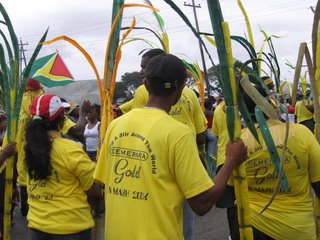
came out from all over to tailgate along the main roads and everything was walkable. We fell asleep to the sound of shouting and bass booming louder than usual on the roads outside, only slightly sunburned ;o)
ps. To my favorite 4th of July Hamel Family Clowning Squad - they stole our idea of the Drusella and Anastasia bussles in the back ... but oh MAN could they shake those things around!! I think we could still teach them Dr. Clowne's emergency routine for next year's Mashramani! And it wasn't NEARLY as fun to watch as it is to participate!!
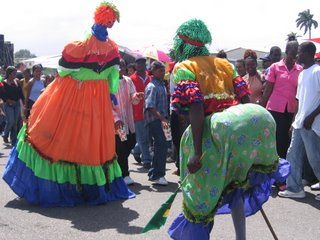
pps. I haven't forgotten - I'm still doing a bit of research for a blog about my ministries - with the confidential nature of the hospital and even more of the HIV program, I can't just share anything I wish to ... I'm still working on it. Sorry for the delay :o(
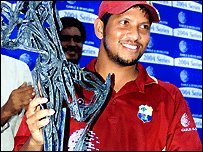




 We had a water balloon fight ... but the balloons were too high quality and they wouldn't burst, no matter how much or little water we put in them ... so we just filled them and squirted them on each other. There was also baby powder ... much baby powder, as you can see in our ghostly shots above.
We had a water balloon fight ... but the balloons were too high quality and they wouldn't burst, no matter how much or little water we put in them ... so we just filled them and squirted them on each other. There was also baby powder ... much baby powder, as you can see in our ghostly shots above. 